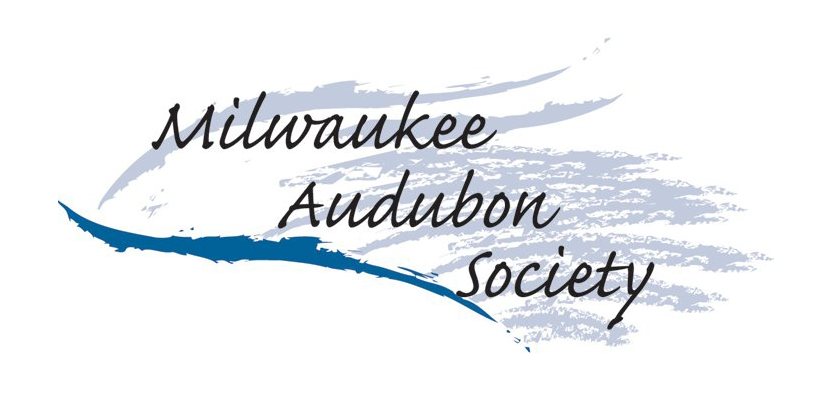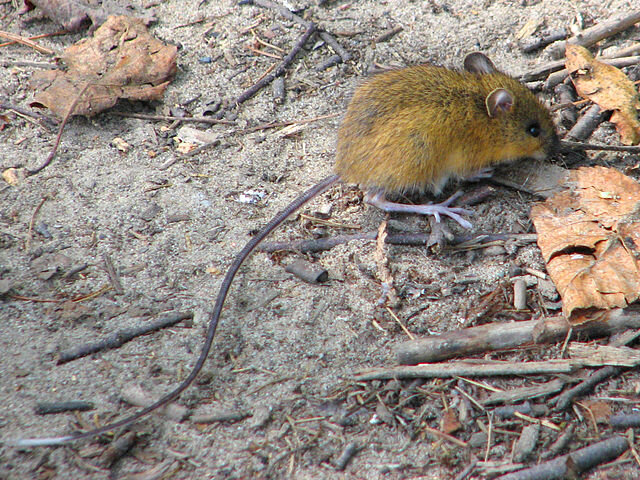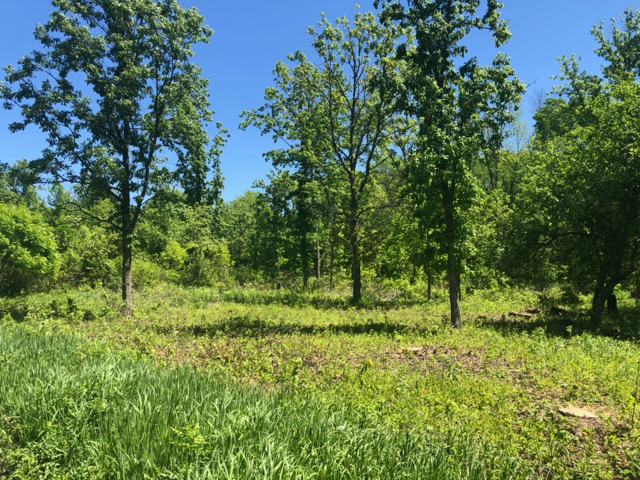Anthropologist June Helm wrote that the greatest human pleasure is discovery. An old horse logger told me that you never get to know a piece of land until you own it, he wasn’t referring to a deed; for him owning meant working and experiencing it.
The Buffalo Speaks Reserve project area has many wonderful attributes that we know something about. As we work this land and care for it, there will be more to learn and more joys to experience.
One of my recent joys came through three jumping mice. As you may have read, we are working toward a weed-free eastern border to MAS property. The weedy edge of our 2018 prairie planting is not the eastern edge of the parcel, but the former field edge west of the planting. Along that historic and well-defined woods-field edge is an intermittent line of field-picked rock harboring many weed species.
Wendy Walcott thought that our most urgent problem this spring was the advance of garlic mustard from the woods into the prairie planting. With this in mind Randy Powers and I went out to the site on Sunday, May 31, with power weed whips to see if we could still “cream” some of the mustard. It was so late in the season and the plants were already so widespread it didn’t take long for Randy to declare that our effort was futile this late in the season.
He proposed that we head back to pick up his commercial walk-behind brush mower to mow out a twenty to thirty foot swath along this edge, making it easier to spray out several weed species after a week’s new growth. One of the problems along this edge is a vigorous growth of one of the largest species of tri-florum clovers. This growth of tri-florum clover may well be based on a seed bank that originated in the sheep-and-wheat era of the mid-1800s. The clover we mowed down would have made any husbandman proud of his/her hay crop.
Napaeozapus Source: D Gordon E. Robertson
At the end of one of the passes, a jumping mouse hopped away from the mower. Since it has been more than forty years since I’d seen Napaeozapus, the woodland jumping mouse, it was fun to see my friend again. In the course of rounds I saw three of these mice hop away, with the typical two or three long bounds, followed by a couple of short hops, and then the hiding crouch. All three of them were south of the acoustic breeding bird monitor set up by Gary Casper and Maddy Reick earlier in the month. Each of these fascinating mice was smaller than I remembered, paler colored than I remembered, and didn’t seem to jump as far as I expected. Just this winter I was working on a school sign text on Napaeozapus and knew that the woodland jumping mouse has been recorded jumping nine feet eight inches.
Napaeozapus is considered very rare in southern Wisconsin, and more typically associated with the conifer component of northern hardwood forest - except where they remain in forest cove locations with water. This makes it possible that Napaeozapus persists along the Niagara Escarpment. When I got home I read that the meadow jumping mouse, Zapus, is a little smaller, and a little paler than Napaeozapus, and only jumps about a third as far. The dense growth within our prairie planting is ideal habitat for Zapus; I had seen the meadow jumping mouse. Both tri-colored species are our most beautiful and elegant mice.
Lithospermum latifolium Source: Mason Brock
Our breeding bird inventory will provide useful data to measure land restoration progress. Randy Powers is keeping track of pollinators and moths. Randy and Maddy Reick are working on a baseline botanic inventory of the Kolterman woods. On their first field run Randy and Maddy were surprised to find two savanna indicator species in our savanna planting within the Kolterman woods. These were wild coffee, or horse gentian, and Lithospermum latifolium, formerly known as woodland puccoon, and now referred to as northern gromwell, a Wisconsin species of special concerns. This native Lithospermum has a co-efficient of conservatism of 8 on a scale of ten meaning that is a site-specific native species and not the introduced European species. In addition to the veteran open-grown oaks of this site and their thirty to fifty year old oak offspring, these two herbaceous species are strong indicators that our site was original savanna. These indicators are part of the answer to Tom Ueberroth’s question, “How are we sure this was savanna?” and they confirm the savanna mapping of the Wisconsin Domesday book of 1937. Our work on this site is true restoration because we have original topography, original soil, veteran trees, and now these savanna indicator species. Over the next few years, other species that have remained dormant or inconspicuous may show themselves.
In addition, we have other inventory and baselines being developed. Rebecca Lane is doing a GPS location and DBH size measurement for each of the young, pole-sized oaks within our savanna restorations. I have asked Gary Casper to write up a proposal for a reptile and amphibian inventory of the escarpment. Jim Price will be able to tell us about glacial relict snail populations and other fauna remaining in the escarpment microhabitats. Randy has documented northern plant species associated with these same microhabitats. And we will want a mammal inventory, not only to document resident mammals, but because dispersing mammals intersecting or moving along the escarpment handrail, or guiding landform, will find habitat value at our Reserve. There is plenty more discovery to come. Now we need you to help with monthly weedings and enjoy Randy’s lessons and wisdom.
On a May 10th walk, Lisa Sattell was deeply moved by an old, open-grown white oak in the woods edge along the 2018 prairie planting. Her sense was that there was a strong vertical energy to the tree even though at a glance one might think of the tree as stout, relative to a forest-grown tree. Nearby big-tooth aspen toppled by straight line winds a couple of years ago showed the development of relatively shallow roots because of the thin depth of soil to bedrock. What Lisa did not know is that oaks in Israel have been shown to root down fifty feet into bedrock cracks. It is possible that the oak that Lisa was drawn to has roots down through the Niagara dolomite and may have gotten down to the moisture on top of underlying Makoqueta shale. That would be a vertical track from groundwater to sky!
After Randy and I finished mowing last week, I stayed on to release the oak Lisa called into attention. Like many savanna veterans this oak’s lower limbs were dying off due to the competition and shading of young mesic pole-sized trees. Release of this old oak tree could extend its life and vigor. In some cases these open grown trees are over-ridden and killed prematurely by mesic pole competition within eighty years.
Savanna edge to Kolterman field reopened by Tom Ueberroth, Jack Wahl, Bill and John Holton. Darker green in foreground is an oat crop planted in the agricultural field. The natural distribution of well-started native oaks of this savanna fringe will soften the hard linear edge of the field when seeded to prairie.
This white oak tree proved to be a little more than thirty inches diameter. By contrast, the original savanna white oaks of downtown Milwaukee measured in the 1830s were typically only twenty inches in diameter. A walk down the western prairie planting edge showed that there are five mature white oaks that average thirty inches in diameter. I took the time for an initial release of all of them and now realize that we could clear a strip seventy feet wide along the prairie planting to expose these veteran trees as a savanna edge to the prairie planting. Most of the big oaks have pending structural problems. If a few of them make it a few more decades we can enjoy their presence and that should give them time to seed in a new generation of young oaks.
Randy has already reported white oaks germinating in the recent prairie planting. We can fence in a few naturally-regenerated oak trees, knowing that the area is a modern deer highway.
Big oaks, little mice, wild coffee, who knows what we will find next? Oh yes, I also measured what may be our largest bur oak at 43 inch diameter. It is located SE of the apiary along the west side of Speaks Creek.
Bill and John Holton, Tom Ueberroth and Jack Wahl have opened up a savanna edge to the Kolterman field, softening the straight line edge of the field. In the attached photo the dark green in the foreground is the oat crop in the open field. Next winter we may see a similar softening featuring thirty-inch diameter white oaks on the cuesta where we will be weeding each month.
Our next volunteer weeding day is this Thursday, June 11th from 6 to 8:30 PM. Telephone Randy at 715-820-2721 if you are able to help, watch, or take pictures. We need your help. Zapus and her friends are calling and you will discover something with Randy. Come, discover, and enjoy.
This jumping mouse, labeled Zapus on the internet, looks more like Napeozapus to me. Both of them are tricolored and are our cutest and most elegant native mice. Tails of both genera are approximately one-and-a-half the length of the rest of the body. Napeozapus can jump more than 9 feet.





